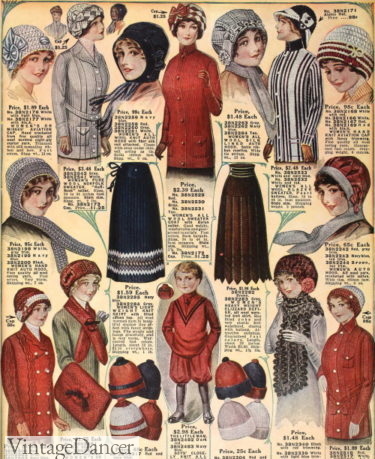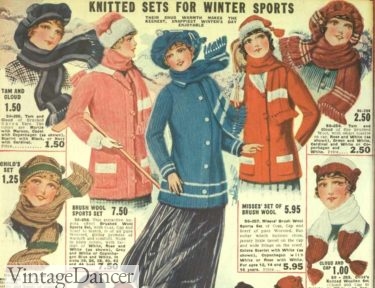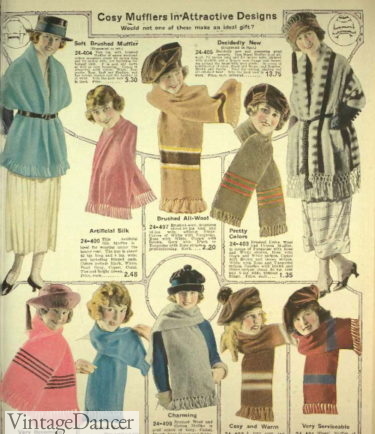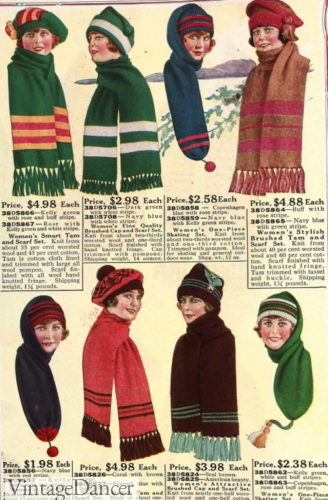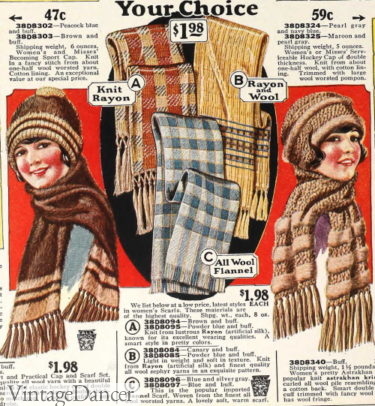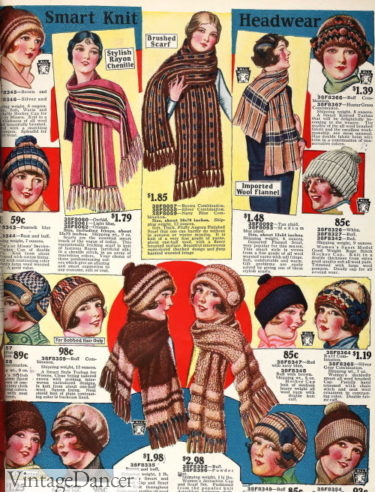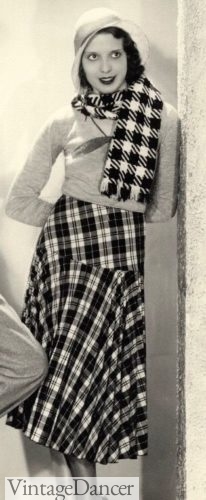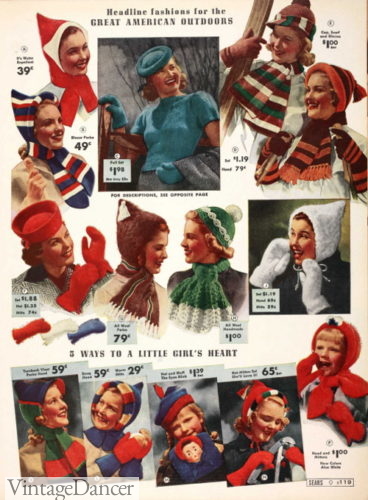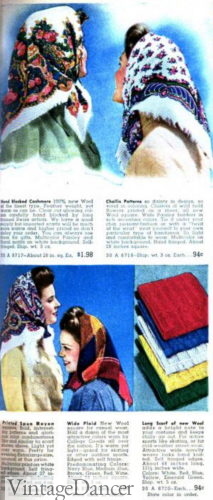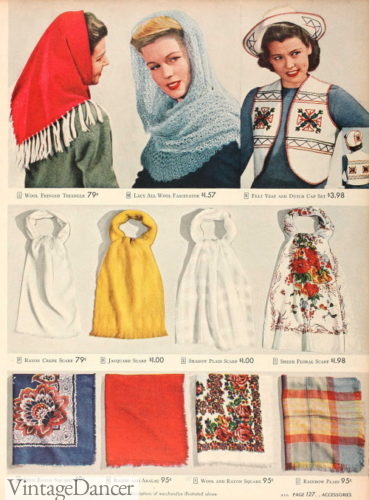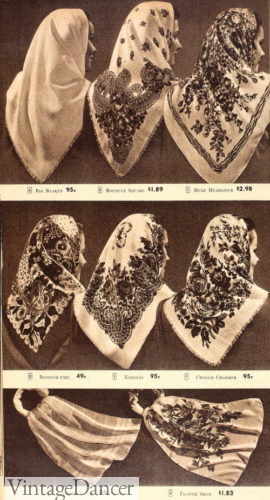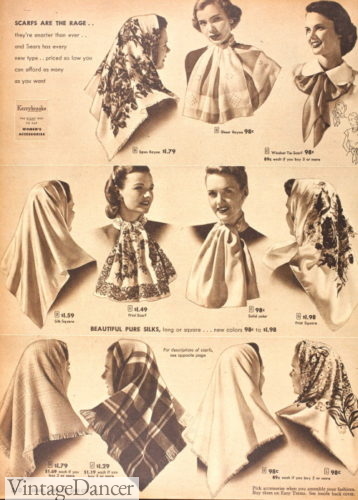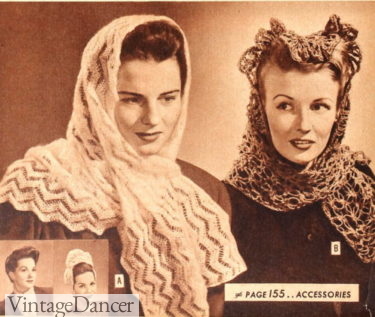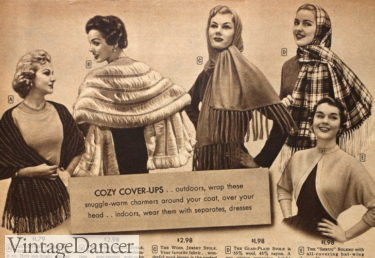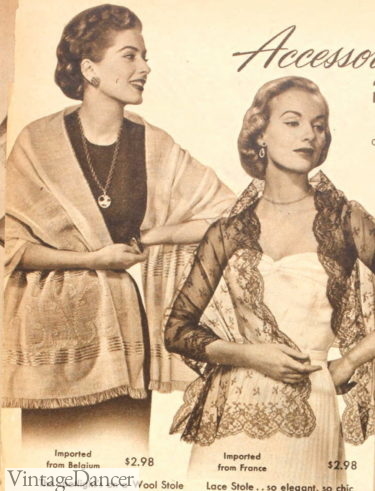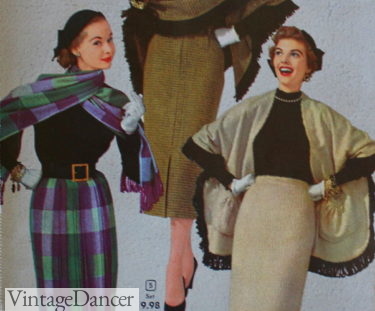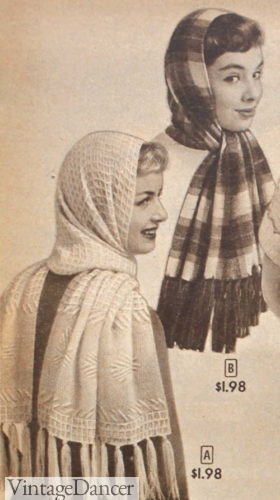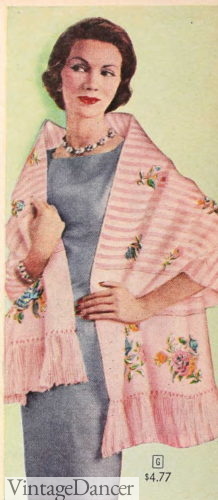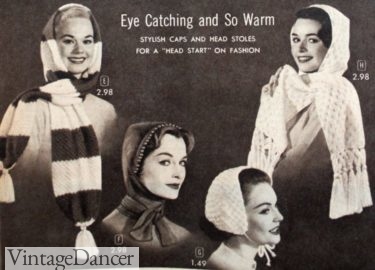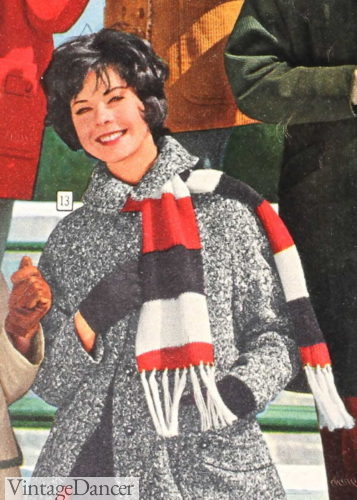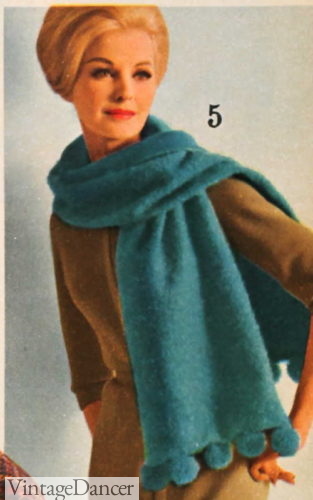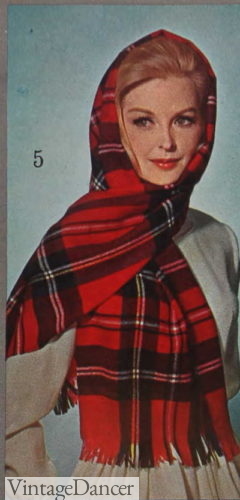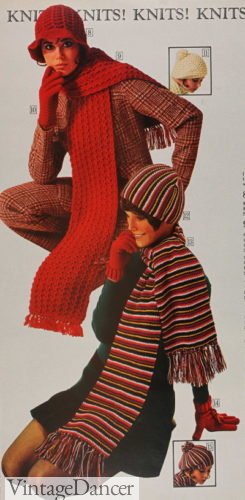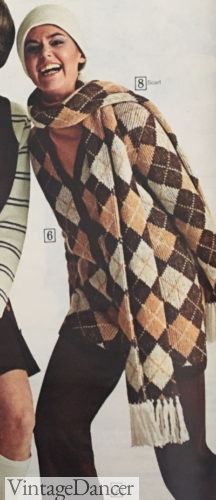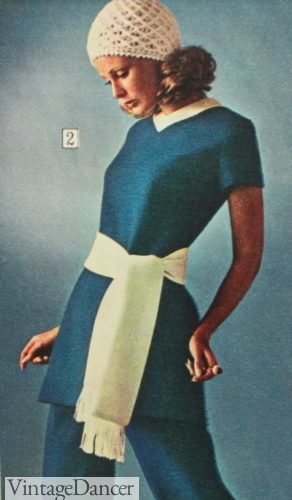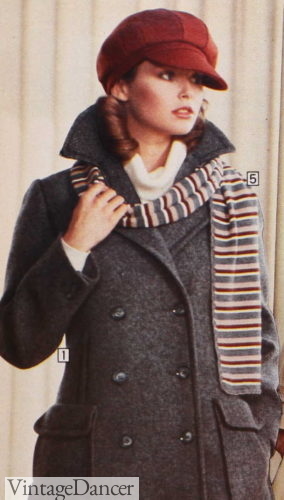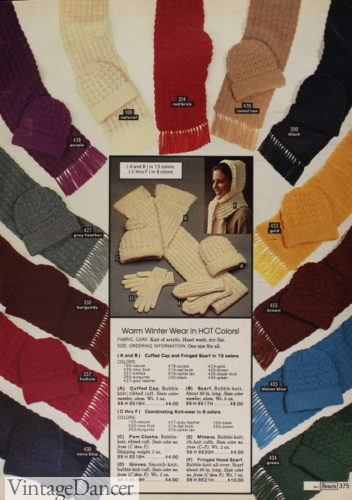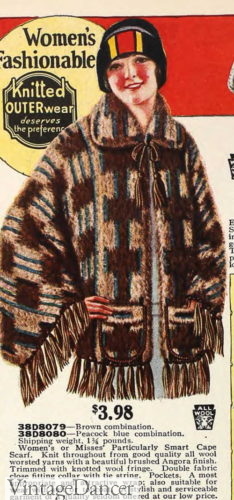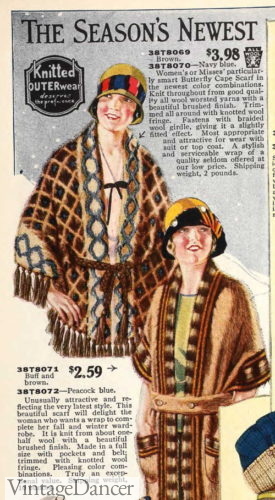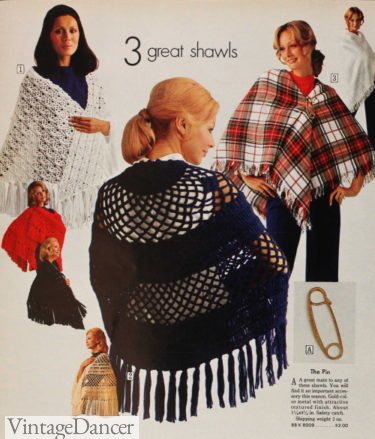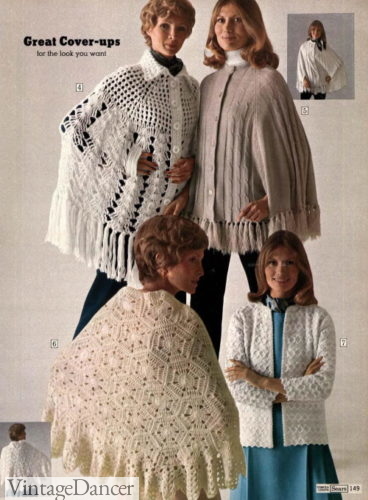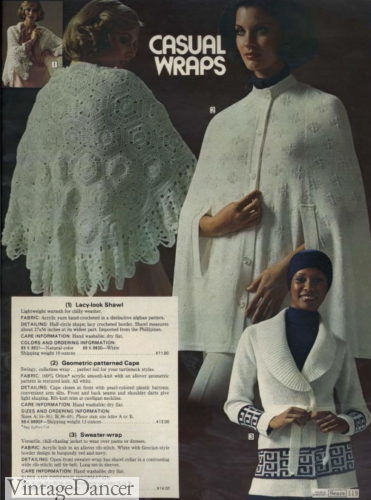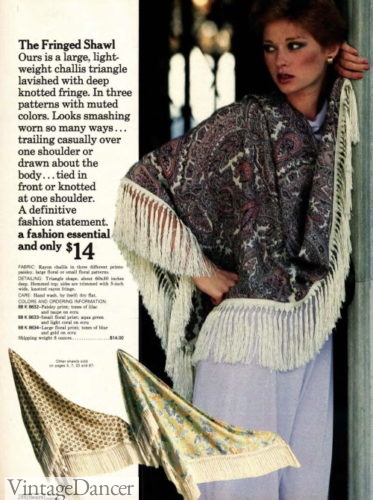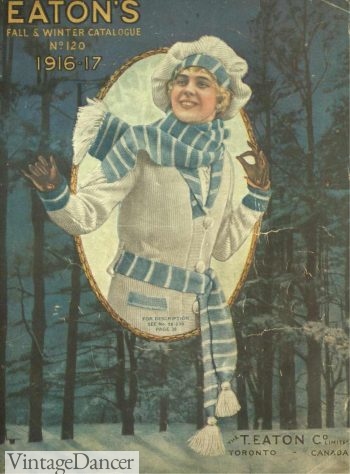
1916 Winter scarf, hat and belt set.
Today’s article will explore styles of 1910s to 1970s vintage scarves, fur stoles, capes, and wraps for winter. From knitted scarves, to shawls, to faux fur stoles, the availability of styles is vast. Depending on the fabric, size, and style, a vintage inspired look can easily be created with the addition of this versatile accessory.
Umbrellas can shield us from the rain — similarly, parasols will protect us from the sun’s powerful rays. Gloves retain heat, as does the topic of today’s article – the scarf. Of course, scarves may be worn all year round, as the sheer variety of styles available may attune to many environments and climates. However, during the colder months of fall and winter, scarves become an important layer of warmth and protection.
Vintage outfits embracing the scarf include the ice skating or skiing outfit- one of my favorites in winter!
Vintage Scarves for Winter – Knitted Styles
Classic knitted scarves are often the form of scarf that comes to mind when considering winter scarves. The long, rectangular shape provides opportunity to wrap the scarf multiple times around the neck, providing insulation and warmth. Various yarns and colors may be utilized, and as such, this style of scarf is the perfect small knitting project for many novice knitters.
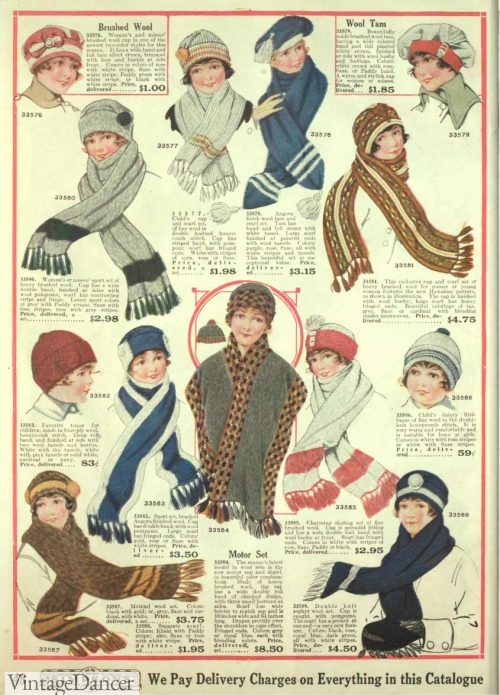
1918 knit scarves and hats
Trends in knit scarves over the decades:
1910s – Thick, extra long chunky knit scarves with long tassels. Wide horizontal stripes on the ends or long vertical stripe edging were very common. Having a matching knit cap,or Tam O’ Shanter hat was essential.
- 1913 knitwear for winter
- 1916 knit scarves, hats cardigans
1920s Winter Scarves
1920 scarves called mufflers, shortened up to waist length by the mid ’20s but grew very wide, almost shawl like, and were now made with lighter, smoother knits. Plaid was a common print, as well as vertical stripes in multiple colors. Pastels were seen in the early 20s for the girlish look.
Matching knit caps featured long floppy “nightcap” tips with a tassel or pom. The 20s saw the Tam O Shanter, large beret, roller or tight knit cloche hat on winter heads.
- 1921 winter scarves
- 1920 scarves and hats
- 1925 plaid or stripe scarves
- 1926 hats and knit scarves
1930s Winter Scarves
1930s scarves were much shorter, to the point of being neck wraps or ascots instead of long wraparound scarves, although both options were available. Fringe, if present, was very short. Instead, edges may be knit into points to echo the Art Deco designs of the day.
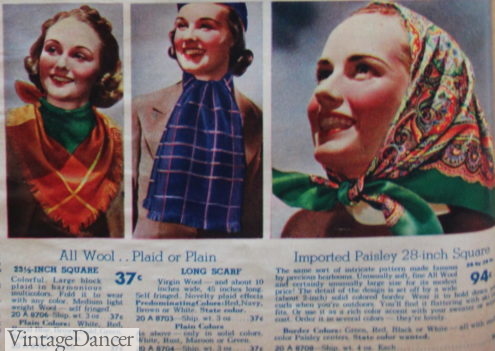
1938 plaid neck scarfs and paisley headscarf
Scotty plaid or tartan was the pattern of the decade. Alternating stripes were classics as well.
Knit scarves were sold with matching hats, sometimes with the scarf strands attached to cover the ears. My favorite 1930s winter hat is the “parka hood” a pointy tip Elf or Robin Hood winter cap.
- A coordinated check skirt and scarf
- 1939 knit hats, scarves and mittens
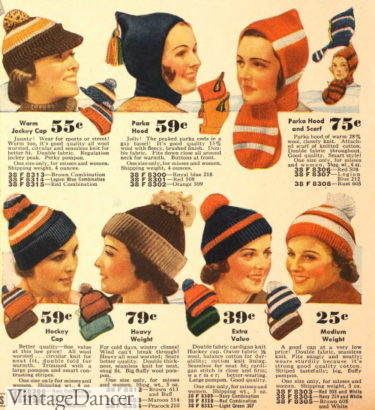
1937 jockey cap, parka hoods and winter caps
Silk scarves could be worn in winter in abstract prints or rich paisley tied in an ascot style and tucked under jacket lapels.
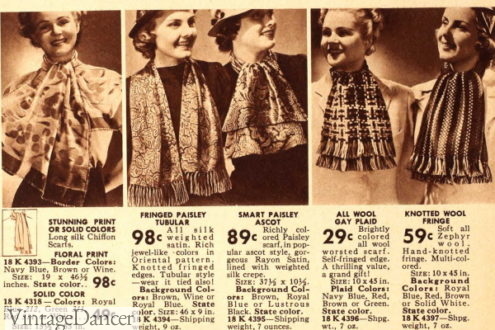
1938 print, paisley silk scarves and plaid or stripe wool knit scarves
The white monogramed scarf was worn by women and men in the 1930s. It took styles notes from Aviator / pilot white silk scarves.
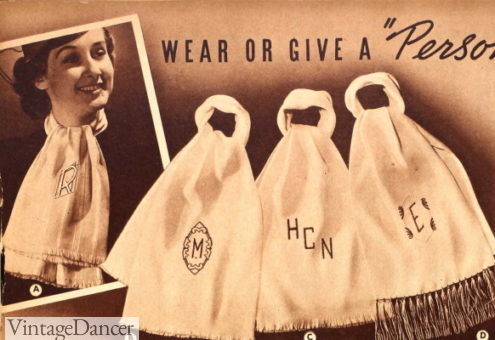
1938 white monogram scarves
1940s Winter Scarves
1940s scarves moved from neckwear to headwear. Triangular scarves wrapped around the head and tied under the chin. Long knotted fringe returned. Solids and prints were equally common.
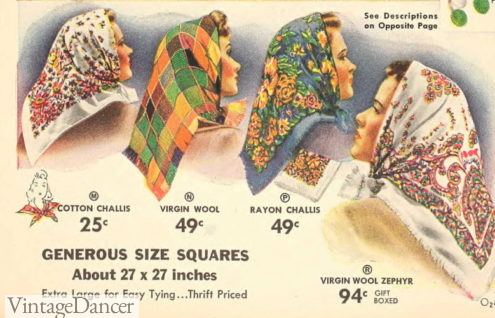
1941 square head scarves
Prints featured florals, paisley, medallions, and scroll work that had an “old world” charm to them. They were sometimes called Babushkas, the Russian name for head scarf.
- 1941 head scarves
- 1944 fringe headscarves and neckscarves
- 1945 head scarves
- 1948 head or neck scarves
- 1943 knit head scarf or tied in a turban
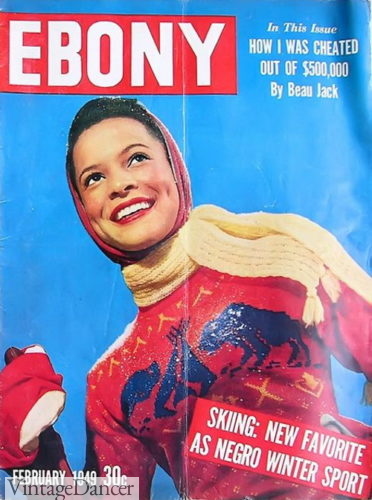
1949 cover of Ebony with a model in ski hat and scarf

1949 Ebony mag quote about using scarves as an accessory
1950s Winter Scarves
The wrap scarf returned and was bigger than ever. Oversized blanket scarves were both long and wide and made in plaid, tweed, textured wools, and stripes. They often coordinated with a coat or other accessories. The long chunky knit scarves of the 1910s returned in the ’50s as well.
In winter, the scarf was knitted into thick rows or sewn from heavy plaid wool with fringe. They were quite wide and heavy (5 feet long, 8-10 inches wide) with an open weave to add texture. They were worn simply wrapped around the neck with one end tossed over the shoulder.
Lighter knits and wools could also be folded in half, tied around the head, under the chin, and both ends tossed over each shoulder. Winter clothing, especially coats, were sold with matching scarves however the art of home knitting was on trend and most winter scarves were handmade.
- 1952 shoulder wraps called stoles, and headwrap scarves
- 1952 Belgium wool or French lace- day to evening scarves
- 1953 scarf wraps
- 1955 knit and plaid wool scarves
- 1958 pink floral knit scarf wrap
- 1957 stripe knit scarf
In 1952, Stitchcraft said “As a change from the ever-lasting head square, buy a yard of rayon of silk- cut it in half lengthways, join the short ends neatly, slip-hem long raw edges, and you have a maneuverable long stole which can be worn in all sorts of ways and is so much prettier and smarter than a triangle tied under your chin. Carry it around on holiday and it will be a godsend for those chilly moments and less bother to carry a cardigan. Worn around your neck, with ends tied at the back under your arms it makes a snug bolero. As a cardigan- around your shoulders then the ends taken under your belt, up and under your belt again in two comfortable pockets. Worn as a stole around the shoulders or over the head with the ends crossed in front and taken back over the shoulders. Tie it around your waist when you don’t want to carry it. ”
Some creative scarf was also called stole cap. Pictured below: “The “Sauciest” thing on fashion’s menu. Warm plaid stole cap of 55% wool and 45% rayon. Has flattering bonnet brim; clip inserts to hug your head. Long fringe adds an extra gay note. 70×14 inches in blue, pink or yellow plaid. ”
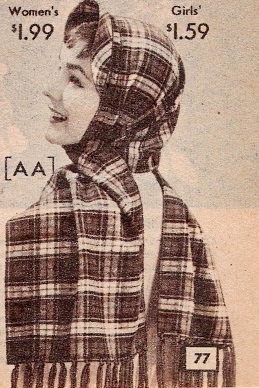
1957 cap stole
Indeed, many hats and scarves of both winter weights and summer sheers were attached to hats, either permanently or with a brooch on either side. A woman could also layer a hat over a sheer scarf. This became a trendy look going into the 60s.
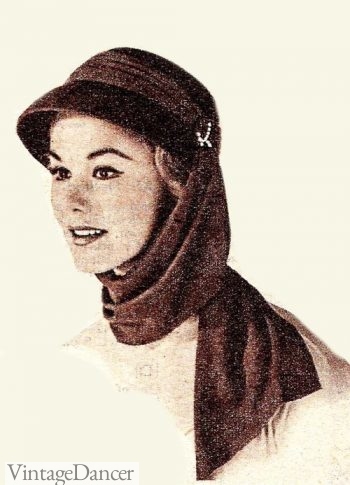
1957 cloche hat with chiffon scarf pinned at the sides
A long and wide scarf could also be turned into a fashionable stole, cardigan or belt. More on those below.
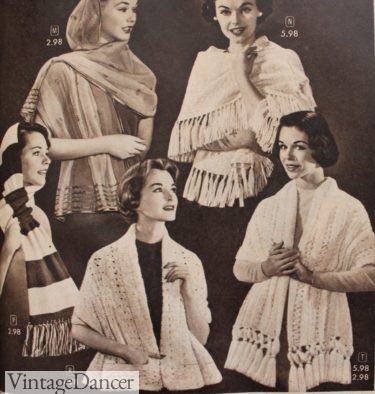
1957 large knit scarves or shawls
1960s -1970s Winter Scarves
The knit scarf was gone by the mid ’60s. A few fuzzy winter scarves with pom pom fringe or plaid wool scarves remained for the coldest climates.
The chunky knit scarf returned in 1970 with a very long (over 6 feet) length and short fringe. Usually stripes or a pattern to match sweaters and cardigans. Some dress designers used a light scarf as a belt over tunic tops.
For the rest of the decade scarves were out of style again only to come back in the 1980s with chunky knits and primary colors.
- 1961 stripe knit scarf
- 1963 pom pom teal fuzzy scarf
- 1964 plaid scarf
- 1970 very long knit scarves
- 1970 matching argyle knit sweater and scarf
- 1970 scarf as a belt
- 1976 skinny stripe scarf
- 1980 matching knit scarves, gloves and hats
Vintage Winter Shawls
Women would adorn themselves in large shawls, displaying beautiful textiles and surface designs at the turn of the century when household heating was limited to a fireplace. At this time, and indeed throughout much of the history of the shawl, the shawl was worn not only as a means to keep warm, but also to be seen as ‘in fashion.’
Victorian, Edwardian and turn of the century shawls were simple knit or elaborate Honeycomb knitwear with fringe. Wool cloth could also be made in shawls in checks and plaids.
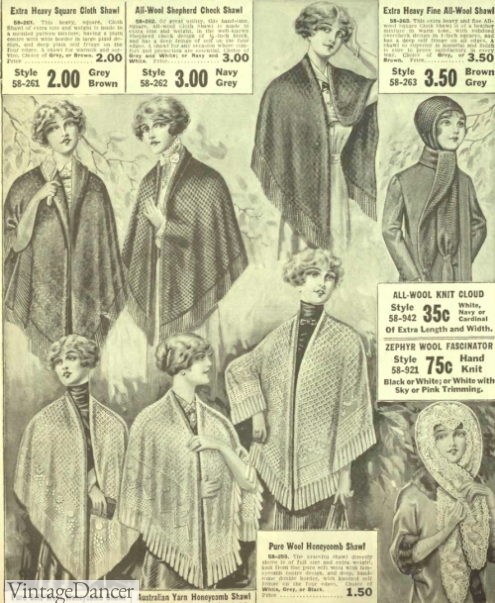
1913 knit honeycomb shawls
To create a 1920s style, drape a shawl or cape over a coat or outerwear. Choose styles featuring bold patterns, embroidery, or even faux fur collars for a perfect vintage look. Naturally, the heavy knit shawl is also timeless. For an evening style, opt for designs incorporating delicate textiles and surface decoration. Fringing, velvet devoré, and beading would all make the perfect finishing touch to a vintage inspired style.
- 1925 cape poncho shawl
- 1924 knit shawls with belt
The knitted shawl return in the 1950s, mostly for home use, like a bed jacket, but they could be worn out and about on a chilly day. White shawls or light pastel colors were preferred.
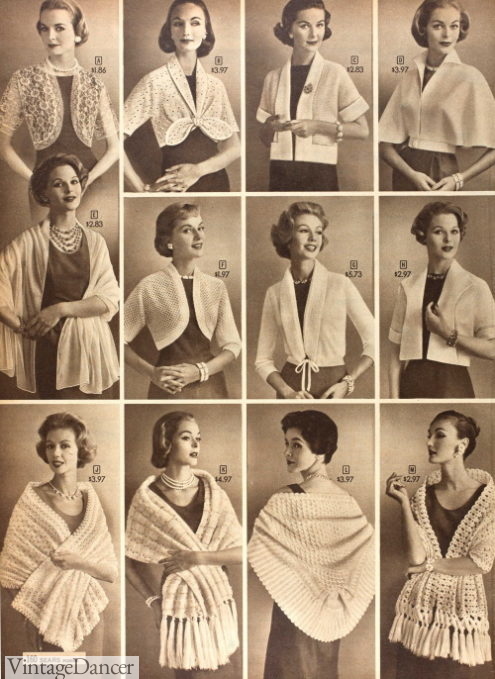
1958 knit shawls, wraps and scarves
The next return was in the 1970s in the form of knit shawls and ponchos. Oversized shawls made ideal coverups and layering pieces. Some women learned to knit so they could make their own.
Fringe shawls in the late 1970s nodded back to the Victorian era while suede fringe shawls were worn by hippies.
- 1972 knit or plaid shawls
- 1974 knit shawls and ponchos
- 1976 knit poncho shawls
- 1978 fringe shawl
Whichever era or decade preferred, there are many styles and choices available to choose from to create a perfect vintage inspired look.
Read More
Vintage Winter Outfits- Ideas to Keep Warm
Vintage Boots- Winter Rain and Snow Boots History
Vintage Hat Styles for Fall/Winter
Debbie Sessions has been teaching fashion history and helping people dress for vintage themed events since 2009. She has turned a hobby into VintageDancer.com with hundreds of well researched articles and hand picked links to vintage inspired clothing online. She aims to make dressing accurately (or not) an affordable option for all. Oh, and she dances too.
